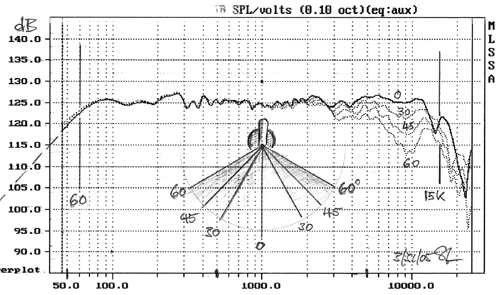|
Specifications and operating characteristics
Typical outdoor frequency response measurement results 
The frequency response, in the horizontal plane which intersects the tweeter, shows a flat trend that rolls off at low frequencies with 12 dB/oct. The -3 dB corner is at 60 Hz. At frequencies above 3 kHz the tweeter becomes directional which is indicated by the increase in response roll-off with larger off-axis angle. Above 10 kHz the concave tweeter dome brings up the off-axis response somewhat. Included in the data, and not corrected for, is the high frequency roll-off of the measuring microphone. Thus the high frequency response corner is at about 15 kHz. Some of the response ripple is due to reflections from objects in the measurement environment.
The frequency response in the vertical plane is well behaved even up to large angles. No lobing effects due to the 1 kHz crossover are noticeable. The increase in measuring distance from 18" at 0 degree to 25" at 45 degree causes a vertical offset of the response curves.
The downward vertical response at -20 degree confirms the overall smoothness of polar response.
The speaker's frequency response is quite independent of distance and merely drops 6 dB for every doubling of distance. The wide angle of radiation and the distance independence of frequency response make near-field listening unproblematic, as long as the speakers are free standing and at least 2 feet away from large surfaces. PLUTO is a physically and also acoustically small source and therefore capable of very precise imaging in a proper setup. The tweeter level can be adjusted +/-2.5 dB. This range allows for correction of driver sensitivity variations between units and for personal preference setting. The above data were taken with the trim potentiometer in its center position. After listening to a wide variety of program material and over an extended period of time in my living room, I have reduced the tweeter level for my speakers by 1 dB. This is a subjectively significant change. It would be difficult to easily make such fine adjustment on a speaker with a passive crossover. That speaker's full potential might never be realized.
Operational behavior With small speakers that produce a very clean sound there can be a tendency to drive them to their maximum capability. We judge a speaker's loudness primarily by how distorted it sounds, and not by how loud we have to talk in order to be understood by the person next to us. PLUTO will give distinct indications when it reaches the limits of its capability. You may note only one of these at a time or various combinations of all of them depending on the program material.
Room placement There is no real limit to room size for PLUTO. A large room probably allows placement far from reflecting surfaces, which is ideal for most speakers, no matter what their polar response. But if you plan to sit further away than the classic stereo sweet spot, which is as far away from each tweeter as the two tweeters are apart from each other, i.e. the apex of the equilateral triangle formed by the the listener's head and the two speakers, then you will loose quickly in soundstage imaging specificity. Preferably you sit even closer than the classic sweet spot. In a small room you may be forced to do exactly that, because of cramped quarters, but since the speakers are light and small they can be placed conveniently. They can be very close to each other and to you, because of their point source like behavior, but they should be at least 2 feet away from large surfaces.
|